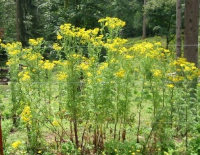Tansy Characteristics
(Tanacetum vulgare, Linn.)

Origins:
Native of Europe.
Natural Order:
Compositæ
Tansy Growing Cycle:
Perennial Herb
Height:
Tansy will grow up to 3 feet tall
Characteristics:
Unbranched stems that bear much-divided, oval, oblong leaves.
Tansy Flowers:
Numerous, small yellow flower-heads in usually crowded corymbs.
How to Grow Tansy
There hasn’t been much written on how to grow tansy. It does well in any moderately fertile garden soil and is easily propagated by division of the clumps or seed. It does so well, that Colorado, Montana, Wyoming and Washington state have included it on their noxious or invasive weeds list. Oddly enough, despite having naturalized in most of North America, it has not naturalized in Alabama, Florida, Georgia, South Carolina, Texas or the Canadian province of Nunavut.
Most information that I have found on how to grow tansy focuses on its growth habits. Care should be given to tansy placement as it spreads easily, both by rhizomes and self-seeding. One source reported that a single common tansy plant could produce as many as 50,000 seeds each season, the average is probably closer to 1,000 to 10,000. Cutting spent blooms before the seeds fall should keep self-seeding to a minimum. Some gardeners prefer the fern-like foliage to the flowers anyway and shear off the flowering stems before they bloom.
Common tansy seeds are believed to be viable for just one season. Seeds can be planted near the surface in the fall and may require a month of cold stratification – perhaps providing an answer why the plant has not naturalized in several south-eastern states. The germination rates increase if the seeds are planted in the spring but they will still need cold stratification.
Growing tansy seedlings prefer open areas with little other established vegetation and high amounts of light. Some scientists have seen a correlation between tansy growth and newly disturbed ground. Its preference is for moist, but well-drained, fertile soil in full sun.
Before planting tansy in your herb garden, check out our Tansy Companion Planting Guide.
Tansy Uses.
Tansy is most frequently grown as an ornamental garden plant, for its ability to add potassium into the soil, as a biologic insect repellent/attractant and as a companion plant. It is used by textile artists as a natural dye and dried for floral arrangements.
Tansy leaves have a bitter taste that were once used to flavor puddings, omelets, salads, stews and other dishes but it is rarely used for that purpose today. Tansy should only be used in small amounts otherwise it may cause stomach upset. Most recommend not allowing pets and livestock to ingest tansy though some scientists note that cattle and other grazing animals eat young tansy plants without noticeable side-effects. (Better to keep them away than find out the hard way they cannot tolerate tansy.)
Recently, I read that tansy nectar is a favorite food of the male mosquito.
Your comment got me curious. I did a little digging. I did find an article on Nature.com that talks about a study that talked in great deal about CO2 emissions, inflorescence and mosquito attraction. What I found mentioned female skeeters moreso than males. I read through the article twice and am left thinking it wasn’t as cut and dried as tansies attract mosquitos. Tansy does seem to produce enough CO2 after dusk to make it useful in their study and the little bloodsuckers do seem to like it’s nectar. But, as to their findings, I admit, I’m not totally understanding the article enough to state if there’s strong guidance that one should perhaps consider tansy as something that attracts rather than repels mosquitos.
Here’s the article I found if anyone’s interested in learning more : Multimodal floral cues guide mosquitoes to tansy inflorescences.
Thank you for posting the article.